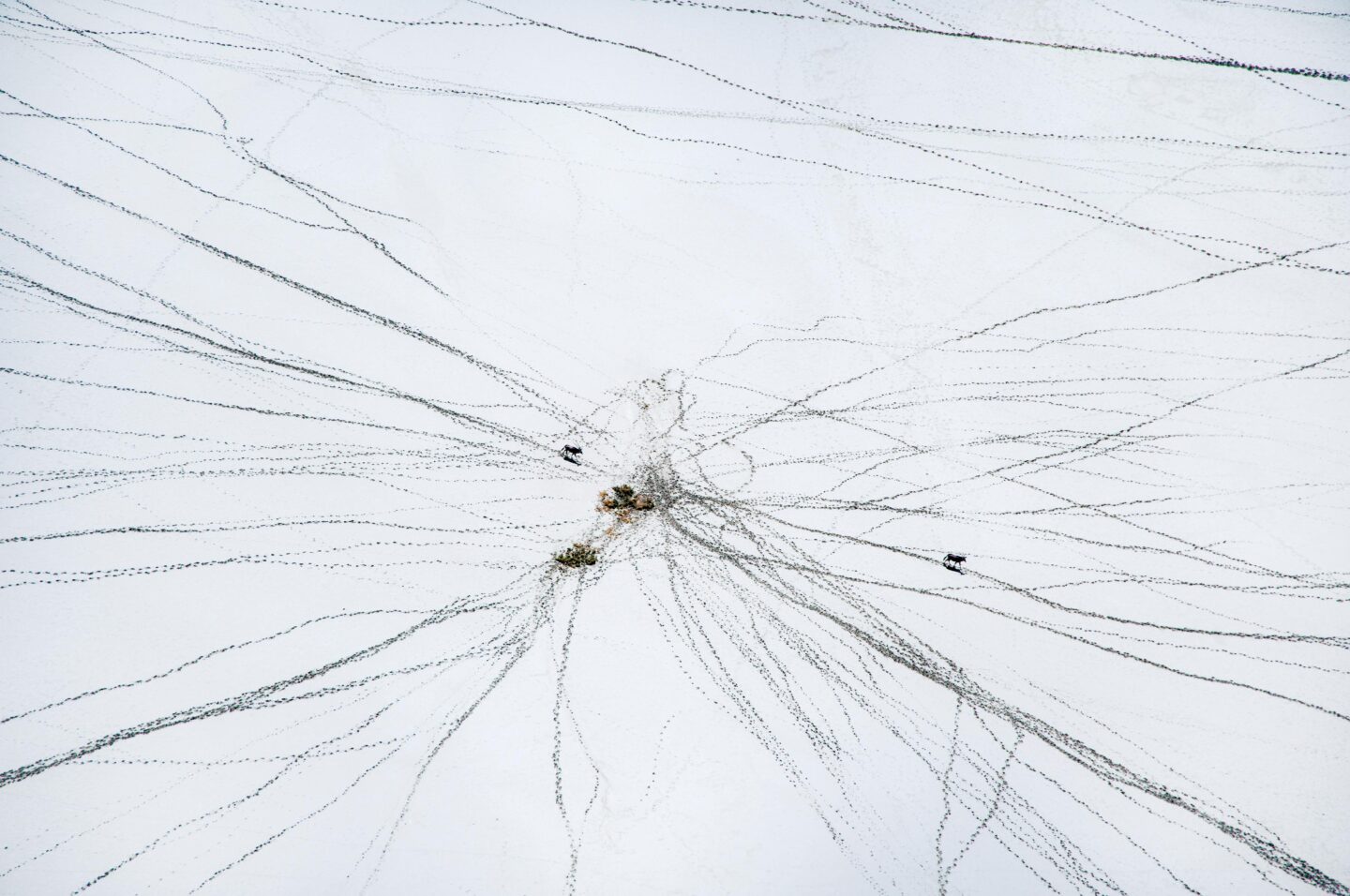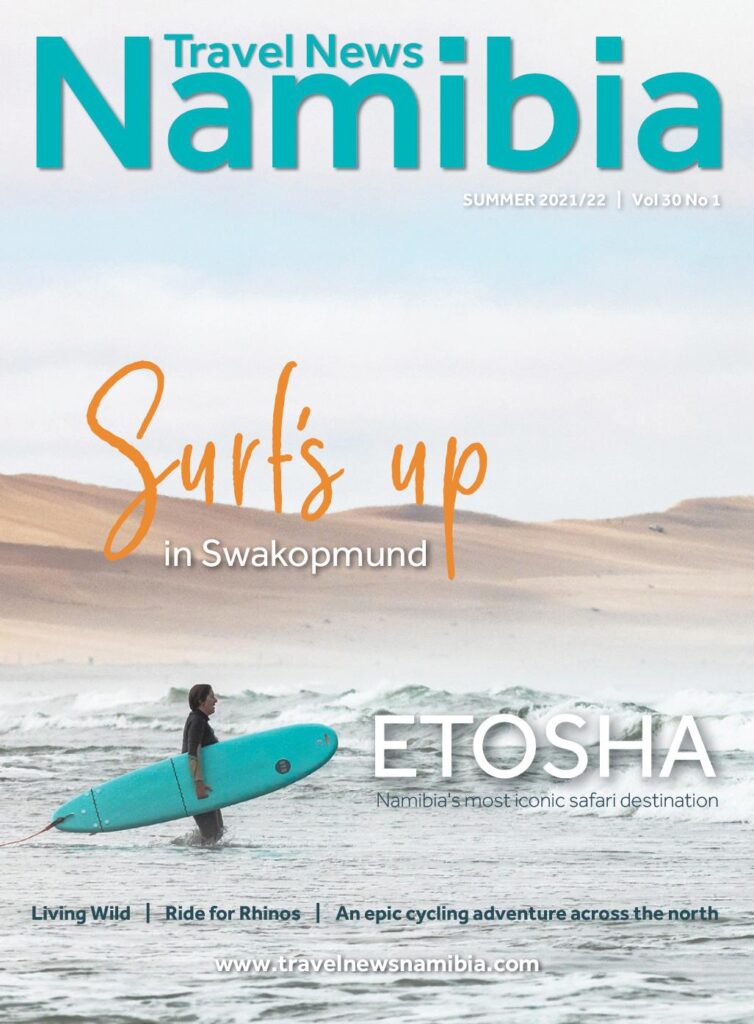

EXPLORING THE GREAT WHITE PLACE
from west to east
Text Willie Olivier | Photographs Willie Olivier & Elzanne MCulloch
From the Summer 2021/22 issue
Etosha, the Great White Place, stretches over a distance of 300 km from west to east as the proverbial crow flies. On my most recent visit I decided to traverse the park from Galton Gate in the west to Von Lindequist gate in the east – a journey of several hundred kilometres.
The park’s western-most reaches are completely unlike the vast plains extending eastwards of the Dolomietberge. Here, the landscape is punctuated by a discontinuous range of low hills and ridges stretching for close to 30 km from north to south. Most Etosha maps show a road close to the park’s western boundary, but this route is no longer open. The waterholes were closed a few years ago to discourage game from congregating close to the western boundary where there is a risk of getting poached or leaving the park when elephants break the fence.
My first port of call was Renostervlei where I did not see any rhinos, but a herd of elephant, Hartmann’s mountain zebra, kudu and gemsbok were in attendance. A short way on the road splits with a choice to continue to Olifantsrus campsite or to follow the road along Dolomietpoort. I opted for the latter.
Western Etosha has a large eland population and at Rateldraf I was overjoyed when I came across eland at the waterhole. They are nomadic and shy antelopes that usually retreat when disturbed. The 16 km out-and-return detour to Klippan was, likewise, rewarding with sightings of red hartebeest, gemsbok, Hartmann’s mountain zebra, blue wildebeest and giraffe.
By now, the temperature was approaching 40 °C and thus it was no surprise that there was little activity at the Dolomietpunt waterhole. From here, the road strikes northeast and for 100 km passes a series of waterholes drilled in the second half of the 1950s along what is generally known as the 19th Degree Latitude. These waterholes were intended to lure elephants into the park which were causing problems on commercial farms in the Kamanjab area.
Olifantsrus campsite has become extremely popular and much to my regret was fully booked for the next week, so I had to push on to Okaukuejo. Unlike the hides in the other rest camps, the Olifantsrus hide is outside the campsite and accessed via an elevated boardwalk. It has an open upper viewing deck that looks down onto the waterhole and the surrounding bush, while the hide on the ground offers eye- level views of the waterhole from behind the safety of large glass windows.
The steel structures at Olifantsrus are a reminder of the hapless lot encountered by some 525 elephants in western Etosha in 1983 and 1985. Until then the borehole was a popular drinking place for elephants, but by a cruel twist of fate Olifantsrus became an abattoir during the devastating drought of the early 1980s. Over a thousand gemsbok and springbok were also culled and the carcasses were processed at the abattoir and transported out of the park in refrigerated trucks.
Ozonjuitji m’Bari, commonly referred to as Mbari, had undergone a complete transformation since my earlier visit during the rainy season when the plains were covered in verdant grassland. The area surrounding the waterhole now resembled a wasteland. Elephants were jostling to quench their thirst while springbok and the other animals were relegated to the sidelines, waiting patiently for their turn.
Unlike my February visit when the plains game had migrated to their summer grazing area, Grootvlakte was now virtually deserted as I made my way to Okaukuejo and the Gondwana Collection’s Etosha Safari Camp. Situated conveniently close to Andersson Gate, its main attraction is without doubt the informal shebeen-style bar with its eclectic collection of memorabilia and the resident Etosha Boys band that entertains guests in the evening.
At the top of my list of waterholes on day two was Okondeka, famous for many years for lion sightings. On approaching the spring I scanned the trees where they often lie during the day, but to no avail. Then, much to my surprise I spotted them lying in the open some distance from the parking area. Next was a quick visit to Newbrownii waterhole. Gemsbokvlakte, my next stop, is the dry season grazing area of the plains game but it could have been named Zebravlakte on account of the huge number of plains zebras at the waterhole and on the surrounding plains.
The saying “patience is a virtue” most certainly also applies to game-viewing, especially towards the end of the dry season. During the heat of the day the animals retreat into the bush to make use of what little shade is available. So it’s not unusual to arrive at a waterhole to find only the odd straggler hanging around. But suddenly, the waterhole comes alive as a seemingly endless parade of animals appears out of nowhere to drink. Then, just as suddenly as they appeared they disappear back into the bush. The waterholes in the Okaukuejo area did not disappoint and delivered elephant, giraffe, plains zebra, gemsbok, springbok, black-faced impala.
Having explored the Okaukuejo area it was time to relocate my base to Halali, so I headed off to Sueda, Charitsaub and Salvadora. At Sueda, a contact spring on the edge of the Etosha Pan, a white rhino was taking a mud bath in the feeble stream of water oozing from the spring. Next up was Charitsaub where the resident lion pride was making the most of what little shade the only tree on the plains produced.
After pitching my tent at Halali it was time for a late afternoon drive to check up on the lions at Charitsaub. They had in the meantime moved into the long shade cast by the solitary tree – almost creating a roadblock. I headed back to Halali and a night vigil at the Moringa waterhole after supper.
Halali was the only rest camp without a waterhole on its perimeter until an artificial waterhole, Moringa, was created in 1992. Set against the slope of Halali Koppie, the viewing deck provides a grandstand view onto the waterhole. My patience was rewarded with sightings of five black rhino, the resident leopard and a spotted hyaena, but the lions which occasionally visit the waterhole did not show up.
On my first visit to Goas there was little activity, but two hours later it was a hive of activity with elephants, plains zebras, black-faced impalas and kudus in attendance. At Nuamses, one of my favourite waterholes, a herd of elephants was slaking their thirst while a throng of plains zebras patiently waited their turn. Their hopes were dashed when another herd of elephants made their appearance at the waterhole.
After two nights camping at Halali I relocated to Namutoni. My journey took me to Goas, Springbokfontein and Batia and I made the detour, which affords expansive views of the Etosha Pan, to Okerfontein. On my way to Namutoni I kept my eyes peeled for cheetahs and much to my joy found two lying in the shade of a thorn tree close to the road.
The Klein Namutoni, Klein Okevi, Groot Okevi, Chudop and Kalkheuwel waterholes are situated close to Namutoni and are ideal for early morning or late afternoon drives. The Fischer’s Pan Drive is a delightful early morning or late afternoon excursion. Unlike February, when the pan was filled with water, it was now just a white expanse of cracked mud. Aroe waterhole was bone dry, and there was no activity at Twee Palms which is now marked by only a single palm tree.
A late afternoon drive to Klein Namutoni waterhole delivered the usual visitors – giraffe, kudu, black-faced impala and plains zebra. Dik-Dik Drive, as always, lived up to its name and despite the recent fire in the area, several of these dainty little antelopes were browsing right next to the road.
On my last morning in the park I decided to make a quick turn to the Klein Namutoni waterhole – a decision I did not regret. I finally spotted the resident leopard to complete my sightings of Etosha’s Big Four. Heading north to Andoni, the plain was still covered in a swathe of tall grass, and except for a lone gemsbok at the Osohama waterhole and a scattering of blue wildebeest and springbok there was little early morning activity. But, much to my delight, I saw five blue cranes in the grasslands near the Andoni waterhole.
Having travelled several hundred kilometres in temperatures approaching 40 °C and visiting 44 waterholes, many of them more than once, my checklist – in addition to Etosha’s Big Four (elephant, rhino, lion and leopard) – had ticks against 20 other species, not to mention the rich diversity of birds. Etosha had, once again, lived up to its reputation of one of Africa’s great game parks. TNN






